Introduction to Management: Structure, Functions, and HR's Role
VerifiedAdded on 2023/06/15
|8
|2162
|491
Report
AI Summary
This report provides an overview of management structures and business functions within an organization, detailing the advantages and disadvantages of different organizational structures such as hierarchical and divisional structures. It explores core and supporting business functions, emphasizing their responsibilities in achieving organizational goals. The report also examines the marketing function and its relationship with other departments, including operations, finance, and human resources. Furthermore, it delves into management functions like planning, organizing, staffing, and controlling, highlighting their roles in managing a business and their interrelationships. Finally, the report discusses talent management, the role of HR in recruiting and performance management, and defines organizational culture, explaining how a positive culture impacts an organization's success by enhancing employee engagement and brand image. The document is available on Desklib, a platform offering a variety of study resources for students.
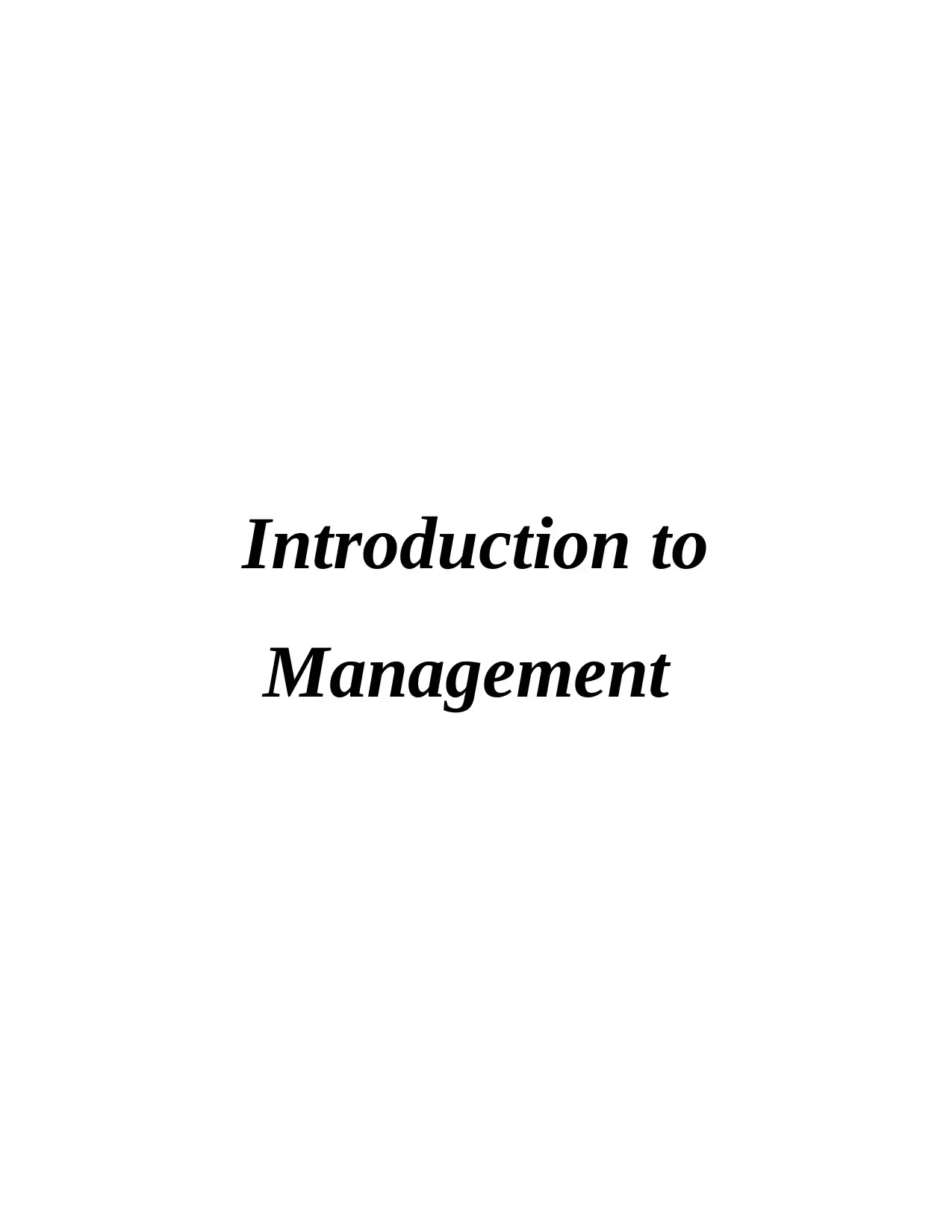
Introduction to
Management
Management
Paraphrase This Document
Need a fresh take? Get an instant paraphrase of this document with our AI Paraphraser
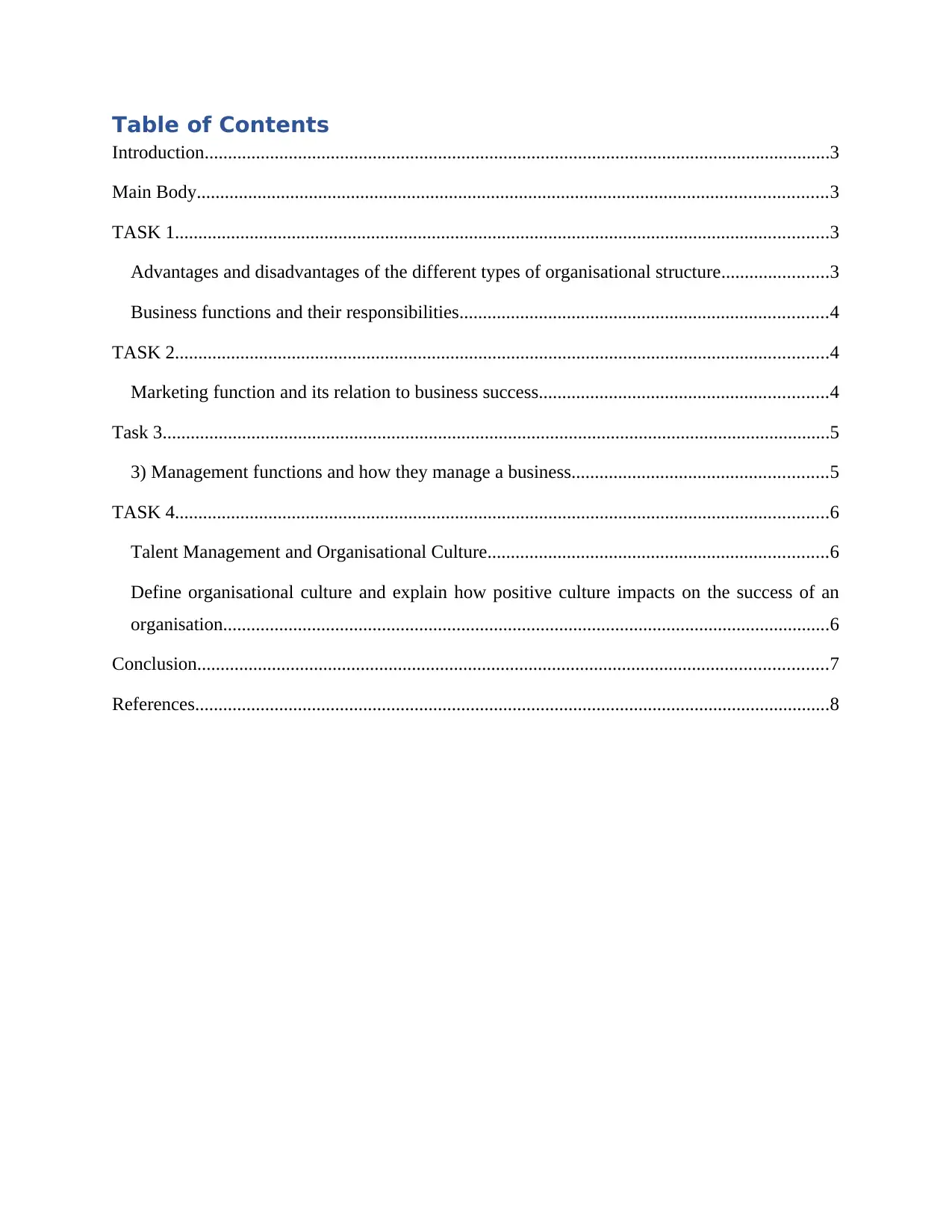
Table of Contents
Introduction......................................................................................................................................3
Main Body.......................................................................................................................................3
TASK 1............................................................................................................................................3
Advantages and disadvantages of the different types of organisational structure.......................3
Business functions and their responsibilities...............................................................................4
TASK 2............................................................................................................................................4
Marketing function and its relation to business success..............................................................4
Task 3...............................................................................................................................................5
3) Management functions and how they manage a business.......................................................5
TASK 4............................................................................................................................................6
Talent Management and Organisational Culture.........................................................................6
Define organisational culture and explain how positive culture impacts on the success of an
organisation..................................................................................................................................6
Conclusion.......................................................................................................................................7
References........................................................................................................................................8
Introduction......................................................................................................................................3
Main Body.......................................................................................................................................3
TASK 1............................................................................................................................................3
Advantages and disadvantages of the different types of organisational structure.......................3
Business functions and their responsibilities...............................................................................4
TASK 2............................................................................................................................................4
Marketing function and its relation to business success..............................................................4
Task 3...............................................................................................................................................5
3) Management functions and how they manage a business.......................................................5
TASK 4............................................................................................................................................6
Talent Management and Organisational Culture.........................................................................6
Define organisational culture and explain how positive culture impacts on the success of an
organisation..................................................................................................................................6
Conclusion.......................................................................................................................................7
References........................................................................................................................................8
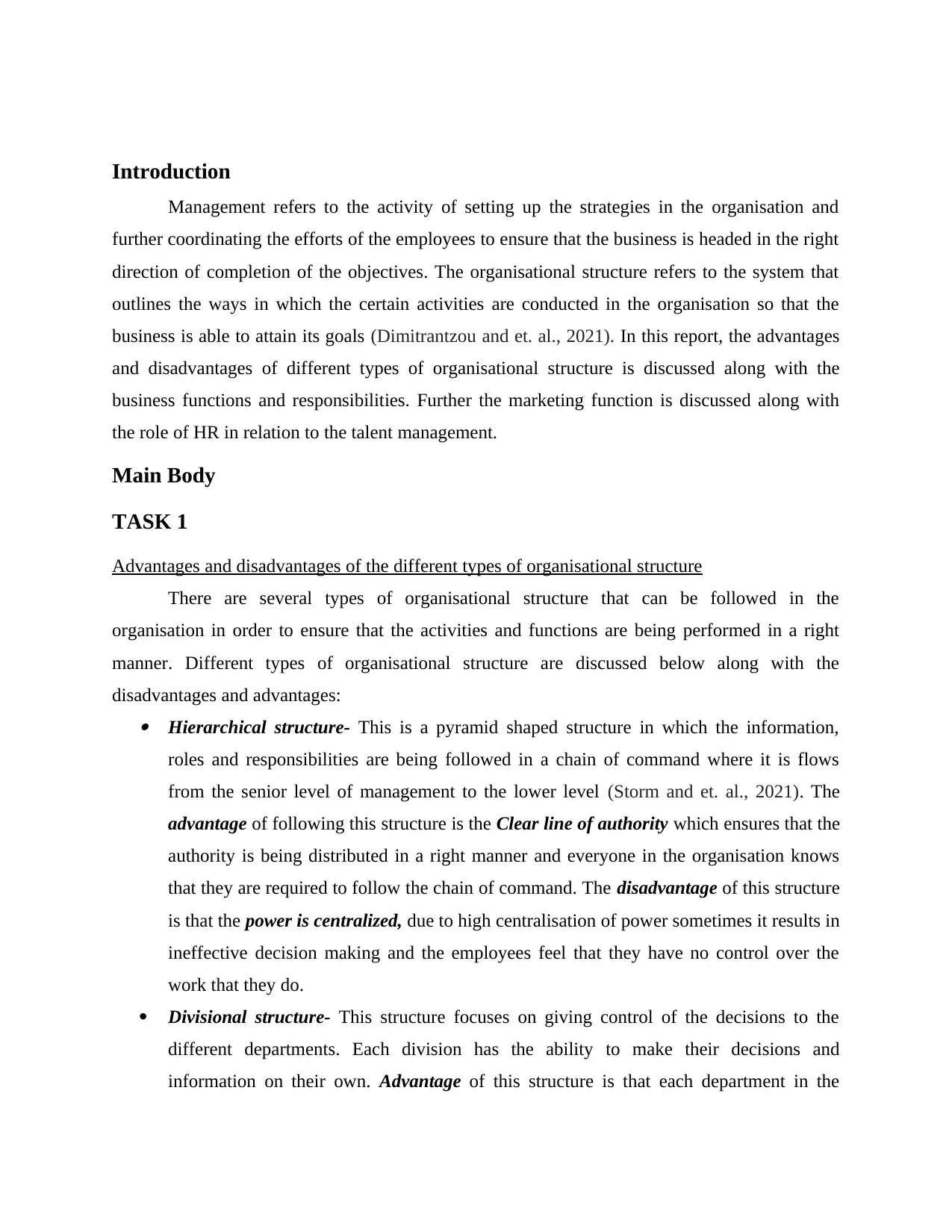
Introduction
Management refers to the activity of setting up the strategies in the organisation and
further coordinating the efforts of the employees to ensure that the business is headed in the right
direction of completion of the objectives. The organisational structure refers to the system that
outlines the ways in which the certain activities are conducted in the organisation so that the
business is able to attain its goals (Dimitrantzou and et. al., 2021). In this report, the advantages
and disadvantages of different types of organisational structure is discussed along with the
business functions and responsibilities. Further the marketing function is discussed along with
the role of HR in relation to the talent management.
Main Body
TASK 1
Advantages and disadvantages of the different types of organisational structure
There are several types of organisational structure that can be followed in the
organisation in order to ensure that the activities and functions are being performed in a right
manner. Different types of organisational structure are discussed below along with the
disadvantages and advantages: Hierarchical structure- This is a pyramid shaped structure in which the information,
roles and responsibilities are being followed in a chain of command where it is flows
from the senior level of management to the lower level (Storm and et. al., 2021). The
advantage of following this structure is the Clear line of authority which ensures that the
authority is being distributed in a right manner and everyone in the organisation knows
that they are required to follow the chain of command. The disadvantage of this structure
is that the power is centralized, due to high centralisation of power sometimes it results in
ineffective decision making and the employees feel that they have no control over the
work that they do.
Divisional structure- This structure focuses on giving control of the decisions to the
different departments. Each division has the ability to make their decisions and
information on their own. Advantage of this structure is that each department in the
Management refers to the activity of setting up the strategies in the organisation and
further coordinating the efforts of the employees to ensure that the business is headed in the right
direction of completion of the objectives. The organisational structure refers to the system that
outlines the ways in which the certain activities are conducted in the organisation so that the
business is able to attain its goals (Dimitrantzou and et. al., 2021). In this report, the advantages
and disadvantages of different types of organisational structure is discussed along with the
business functions and responsibilities. Further the marketing function is discussed along with
the role of HR in relation to the talent management.
Main Body
TASK 1
Advantages and disadvantages of the different types of organisational structure
There are several types of organisational structure that can be followed in the
organisation in order to ensure that the activities and functions are being performed in a right
manner. Different types of organisational structure are discussed below along with the
disadvantages and advantages: Hierarchical structure- This is a pyramid shaped structure in which the information,
roles and responsibilities are being followed in a chain of command where it is flows
from the senior level of management to the lower level (Storm and et. al., 2021). The
advantage of following this structure is the Clear line of authority which ensures that the
authority is being distributed in a right manner and everyone in the organisation knows
that they are required to follow the chain of command. The disadvantage of this structure
is that the power is centralized, due to high centralisation of power sometimes it results in
ineffective decision making and the employees feel that they have no control over the
work that they do.
Divisional structure- This structure focuses on giving control of the decisions to the
different departments. Each division has the ability to make their decisions and
information on their own. Advantage of this structure is that each department in the
⊘ This is a preview!⊘
Do you want full access?
Subscribe today to unlock all pages.

Trusted by 1+ million students worldwide
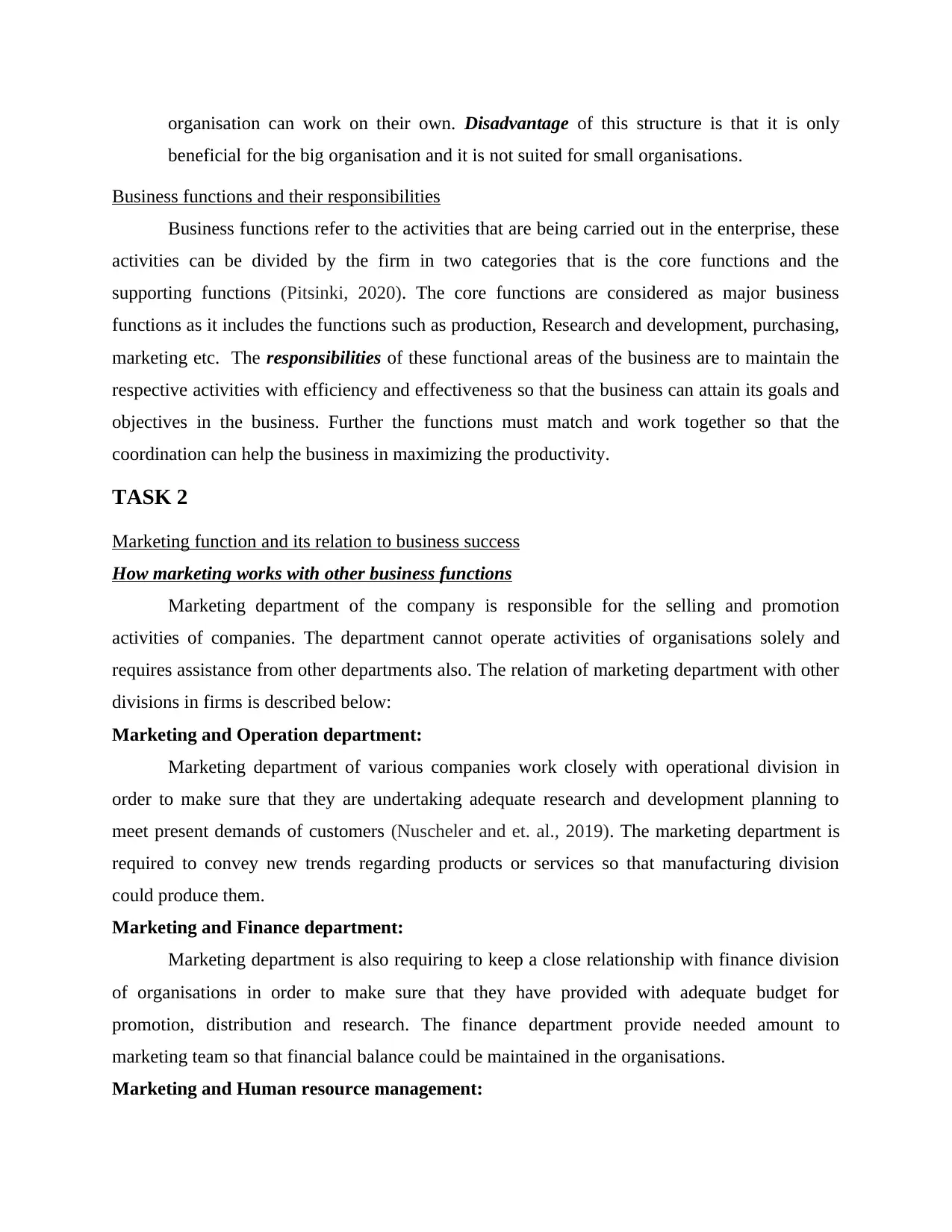
organisation can work on their own. Disadvantage of this structure is that it is only
beneficial for the big organisation and it is not suited for small organisations.
Business functions and their responsibilities
Business functions refer to the activities that are being carried out in the enterprise, these
activities can be divided by the firm in two categories that is the core functions and the
supporting functions (Pitsinki, 2020). The core functions are considered as major business
functions as it includes the functions such as production, Research and development, purchasing,
marketing etc. The responsibilities of these functional areas of the business are to maintain the
respective activities with efficiency and effectiveness so that the business can attain its goals and
objectives in the business. Further the functions must match and work together so that the
coordination can help the business in maximizing the productivity.
TASK 2
Marketing function and its relation to business success
How marketing works with other business functions
Marketing department of the company is responsible for the selling and promotion
activities of companies. The department cannot operate activities of organisations solely and
requires assistance from other departments also. The relation of marketing department with other
divisions in firms is described below:
Marketing and Operation department:
Marketing department of various companies work closely with operational division in
order to make sure that they are undertaking adequate research and development planning to
meet present demands of customers (Nuscheler and et. al., 2019). The marketing department is
required to convey new trends regarding products or services so that manufacturing division
could produce them.
Marketing and Finance department:
Marketing department is also requiring to keep a close relationship with finance division
of organisations in order to make sure that they have provided with adequate budget for
promotion, distribution and research. The finance department provide needed amount to
marketing team so that financial balance could be maintained in the organisations.
Marketing and Human resource management:
beneficial for the big organisation and it is not suited for small organisations.
Business functions and their responsibilities
Business functions refer to the activities that are being carried out in the enterprise, these
activities can be divided by the firm in two categories that is the core functions and the
supporting functions (Pitsinki, 2020). The core functions are considered as major business
functions as it includes the functions such as production, Research and development, purchasing,
marketing etc. The responsibilities of these functional areas of the business are to maintain the
respective activities with efficiency and effectiveness so that the business can attain its goals and
objectives in the business. Further the functions must match and work together so that the
coordination can help the business in maximizing the productivity.
TASK 2
Marketing function and its relation to business success
How marketing works with other business functions
Marketing department of the company is responsible for the selling and promotion
activities of companies. The department cannot operate activities of organisations solely and
requires assistance from other departments also. The relation of marketing department with other
divisions in firms is described below:
Marketing and Operation department:
Marketing department of various companies work closely with operational division in
order to make sure that they are undertaking adequate research and development planning to
meet present demands of customers (Nuscheler and et. al., 2019). The marketing department is
required to convey new trends regarding products or services so that manufacturing division
could produce them.
Marketing and Finance department:
Marketing department is also requiring to keep a close relationship with finance division
of organisations in order to make sure that they have provided with adequate budget for
promotion, distribution and research. The finance department provide needed amount to
marketing team so that financial balance could be maintained in the organisations.
Marketing and Human resource management:
Paraphrase This Document
Need a fresh take? Get an instant paraphrase of this document with our AI Paraphraser
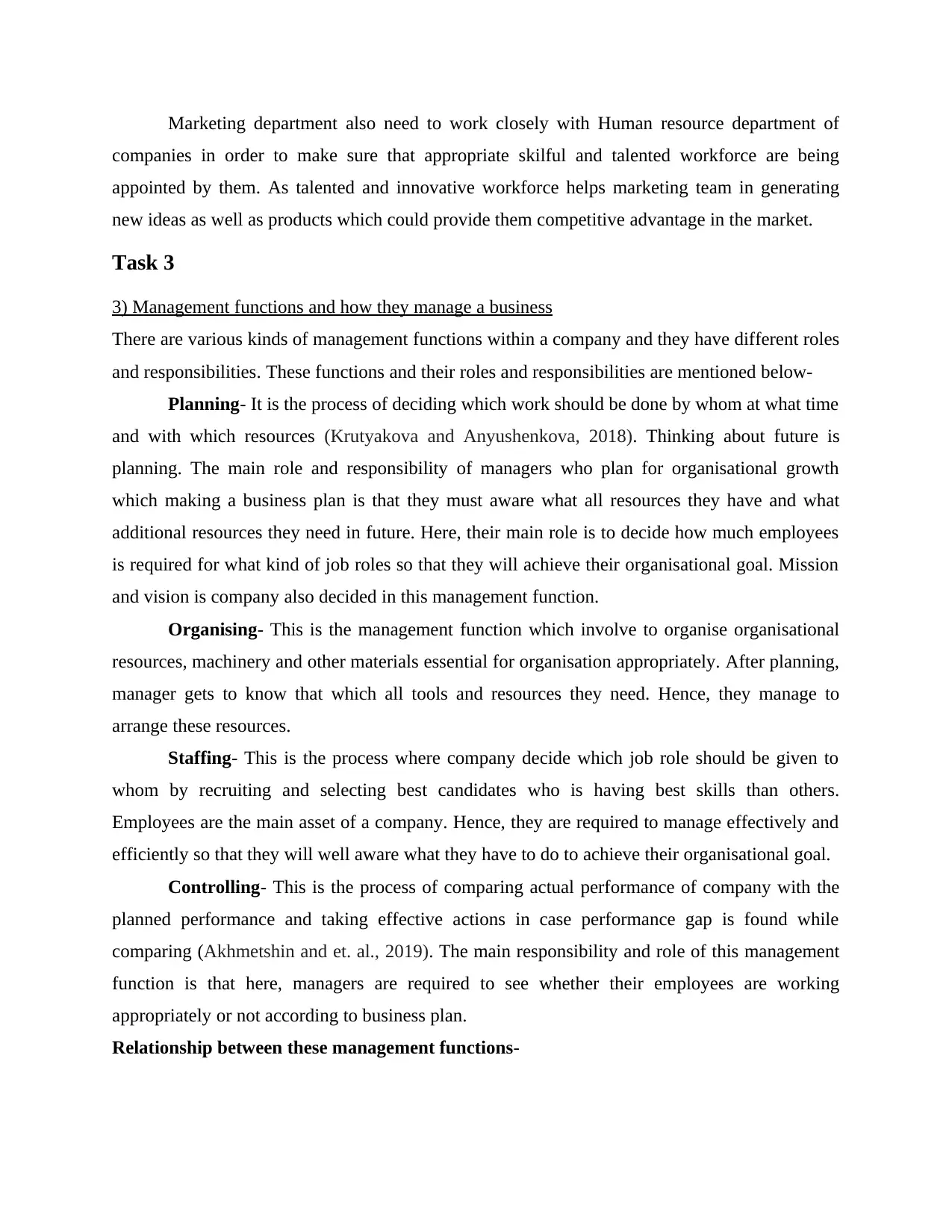
Marketing department also need to work closely with Human resource department of
companies in order to make sure that appropriate skilful and talented workforce are being
appointed by them. As talented and innovative workforce helps marketing team in generating
new ideas as well as products which could provide them competitive advantage in the market.
Task 3
3) Management functions and how they manage a business
There are various kinds of management functions within a company and they have different roles
and responsibilities. These functions and their roles and responsibilities are mentioned below-
Planning- It is the process of deciding which work should be done by whom at what time
and with which resources (Krutyakova and Anyushenkova, 2018). Thinking about future is
planning. The main role and responsibility of managers who plan for organisational growth
which making a business plan is that they must aware what all resources they have and what
additional resources they need in future. Here, their main role is to decide how much employees
is required for what kind of job roles so that they will achieve their organisational goal. Mission
and vision is company also decided in this management function.
Organising- This is the management function which involve to organise organisational
resources, machinery and other materials essential for organisation appropriately. After planning,
manager gets to know that which all tools and resources they need. Hence, they manage to
arrange these resources.
Staffing- This is the process where company decide which job role should be given to
whom by recruiting and selecting best candidates who is having best skills than others.
Employees are the main asset of a company. Hence, they are required to manage effectively and
efficiently so that they will well aware what they have to do to achieve their organisational goal.
Controlling- This is the process of comparing actual performance of company with the
planned performance and taking effective actions in case performance gap is found while
comparing (Akhmetshin and et. al., 2019). The main responsibility and role of this management
function is that here, managers are required to see whether their employees are working
appropriately or not according to business plan.
Relationship between these management functions-
companies in order to make sure that appropriate skilful and talented workforce are being
appointed by them. As talented and innovative workforce helps marketing team in generating
new ideas as well as products which could provide them competitive advantage in the market.
Task 3
3) Management functions and how they manage a business
There are various kinds of management functions within a company and they have different roles
and responsibilities. These functions and their roles and responsibilities are mentioned below-
Planning- It is the process of deciding which work should be done by whom at what time
and with which resources (Krutyakova and Anyushenkova, 2018). Thinking about future is
planning. The main role and responsibility of managers who plan for organisational growth
which making a business plan is that they must aware what all resources they have and what
additional resources they need in future. Here, their main role is to decide how much employees
is required for what kind of job roles so that they will achieve their organisational goal. Mission
and vision is company also decided in this management function.
Organising- This is the management function which involve to organise organisational
resources, machinery and other materials essential for organisation appropriately. After planning,
manager gets to know that which all tools and resources they need. Hence, they manage to
arrange these resources.
Staffing- This is the process where company decide which job role should be given to
whom by recruiting and selecting best candidates who is having best skills than others.
Employees are the main asset of a company. Hence, they are required to manage effectively and
efficiently so that they will well aware what they have to do to achieve their organisational goal.
Controlling- This is the process of comparing actual performance of company with the
planned performance and taking effective actions in case performance gap is found while
comparing (Akhmetshin and et. al., 2019). The main responsibility and role of this management
function is that here, managers are required to see whether their employees are working
appropriately or not according to business plan.
Relationship between these management functions-
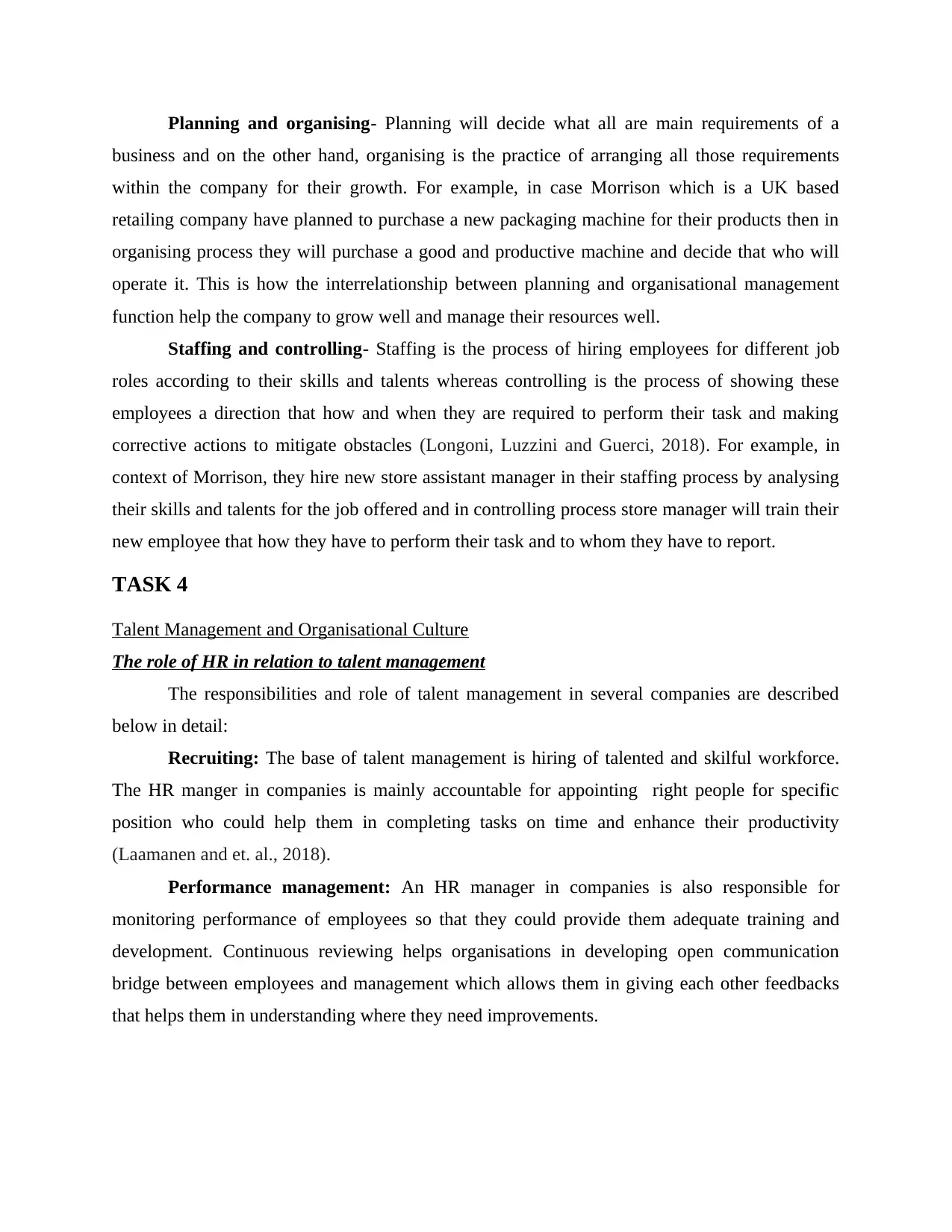
Planning and organising- Planning will decide what all are main requirements of a
business and on the other hand, organising is the practice of arranging all those requirements
within the company for their growth. For example, in case Morrison which is a UK based
retailing company have planned to purchase a new packaging machine for their products then in
organising process they will purchase a good and productive machine and decide that who will
operate it. This is how the interrelationship between planning and organisational management
function help the company to grow well and manage their resources well.
Staffing and controlling- Staffing is the process of hiring employees for different job
roles according to their skills and talents whereas controlling is the process of showing these
employees a direction that how and when they are required to perform their task and making
corrective actions to mitigate obstacles (Longoni, Luzzini and Guerci, 2018). For example, in
context of Morrison, they hire new store assistant manager in their staffing process by analysing
their skills and talents for the job offered and in controlling process store manager will train their
new employee that how they have to perform their task and to whom they have to report.
TASK 4
Talent Management and Organisational Culture
The role of HR in relation to talent management
The responsibilities and role of talent management in several companies are described
below in detail:
Recruiting: The base of talent management is hiring of talented and skilful workforce.
The HR manger in companies is mainly accountable for appointing right people for specific
position who could help them in completing tasks on time and enhance their productivity
(Laamanen and et. al., 2018).
Performance management: An HR manager in companies is also responsible for
monitoring performance of employees so that they could provide them adequate training and
development. Continuous reviewing helps organisations in developing open communication
bridge between employees and management which allows them in giving each other feedbacks
that helps them in understanding where they need improvements.
business and on the other hand, organising is the practice of arranging all those requirements
within the company for their growth. For example, in case Morrison which is a UK based
retailing company have planned to purchase a new packaging machine for their products then in
organising process they will purchase a good and productive machine and decide that who will
operate it. This is how the interrelationship between planning and organisational management
function help the company to grow well and manage their resources well.
Staffing and controlling- Staffing is the process of hiring employees for different job
roles according to their skills and talents whereas controlling is the process of showing these
employees a direction that how and when they are required to perform their task and making
corrective actions to mitigate obstacles (Longoni, Luzzini and Guerci, 2018). For example, in
context of Morrison, they hire new store assistant manager in their staffing process by analysing
their skills and talents for the job offered and in controlling process store manager will train their
new employee that how they have to perform their task and to whom they have to report.
TASK 4
Talent Management and Organisational Culture
The role of HR in relation to talent management
The responsibilities and role of talent management in several companies are described
below in detail:
Recruiting: The base of talent management is hiring of talented and skilful workforce.
The HR manger in companies is mainly accountable for appointing right people for specific
position who could help them in completing tasks on time and enhance their productivity
(Laamanen and et. al., 2018).
Performance management: An HR manager in companies is also responsible for
monitoring performance of employees so that they could provide them adequate training and
development. Continuous reviewing helps organisations in developing open communication
bridge between employees and management which allows them in giving each other feedbacks
that helps them in understanding where they need improvements.
⊘ This is a preview!⊘
Do you want full access?
Subscribe today to unlock all pages.

Trusted by 1+ million students worldwide
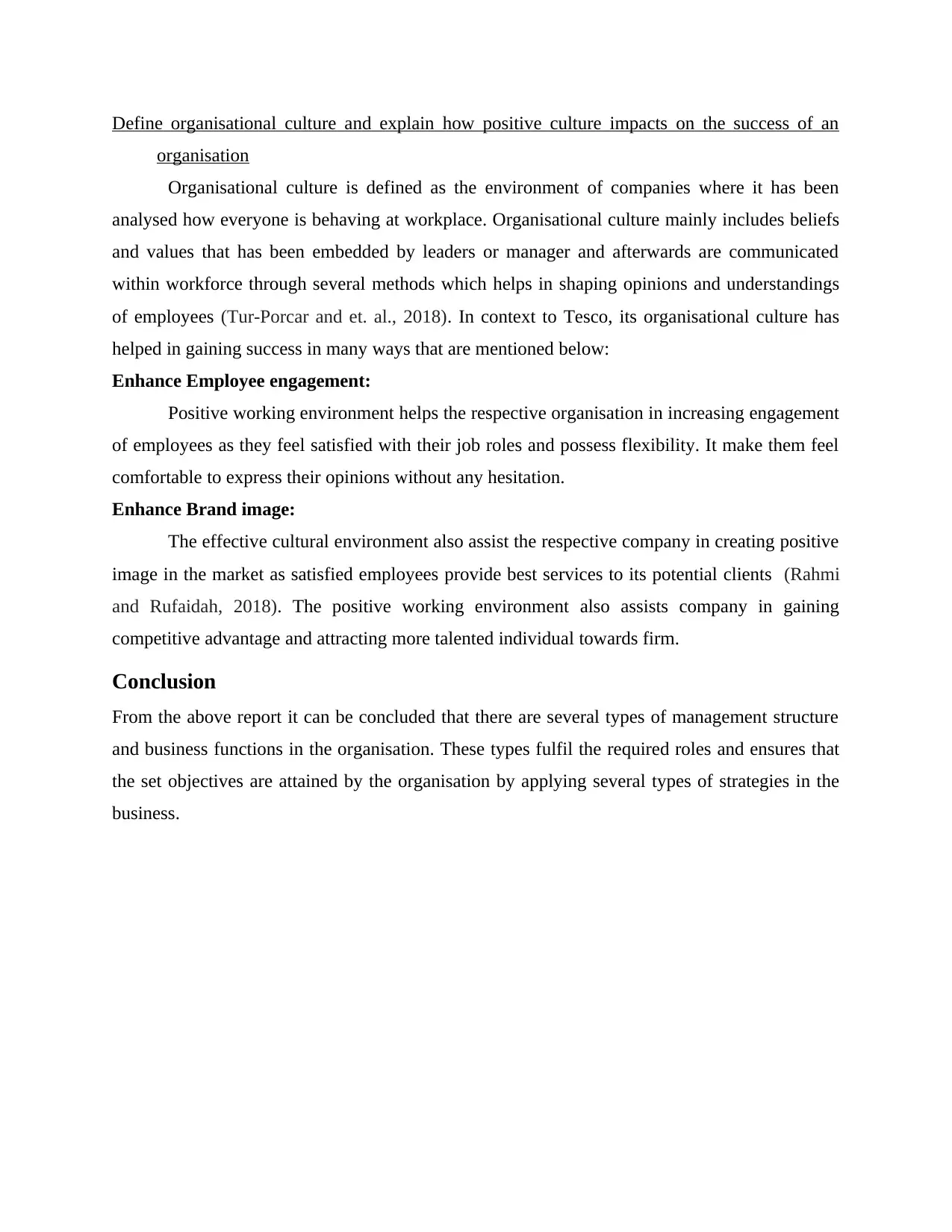
Define organisational culture and explain how positive culture impacts on the success of an
organisation
Organisational culture is defined as the environment of companies where it has been
analysed how everyone is behaving at workplace. Organisational culture mainly includes beliefs
and values that has been embedded by leaders or manager and afterwards are communicated
within workforce through several methods which helps in shaping opinions and understandings
of employees (Tur-Porcar and et. al., 2018). In context to Tesco, its organisational culture has
helped in gaining success in many ways that are mentioned below:
Enhance Employee engagement:
Positive working environment helps the respective organisation in increasing engagement
of employees as they feel satisfied with their job roles and possess flexibility. It make them feel
comfortable to express their opinions without any hesitation.
Enhance Brand image:
The effective cultural environment also assist the respective company in creating positive
image in the market as satisfied employees provide best services to its potential clients (Rahmi
and Rufaidah, 2018). The positive working environment also assists company in gaining
competitive advantage and attracting more talented individual towards firm.
Conclusion
From the above report it can be concluded that there are several types of management structure
and business functions in the organisation. These types fulfil the required roles and ensures that
the set objectives are attained by the organisation by applying several types of strategies in the
business.
organisation
Organisational culture is defined as the environment of companies where it has been
analysed how everyone is behaving at workplace. Organisational culture mainly includes beliefs
and values that has been embedded by leaders or manager and afterwards are communicated
within workforce through several methods which helps in shaping opinions and understandings
of employees (Tur-Porcar and et. al., 2018). In context to Tesco, its organisational culture has
helped in gaining success in many ways that are mentioned below:
Enhance Employee engagement:
Positive working environment helps the respective organisation in increasing engagement
of employees as they feel satisfied with their job roles and possess flexibility. It make them feel
comfortable to express their opinions without any hesitation.
Enhance Brand image:
The effective cultural environment also assist the respective company in creating positive
image in the market as satisfied employees provide best services to its potential clients (Rahmi
and Rufaidah, 2018). The positive working environment also assists company in gaining
competitive advantage and attracting more talented individual towards firm.
Conclusion
From the above report it can be concluded that there are several types of management structure
and business functions in the organisation. These types fulfil the required roles and ensures that
the set objectives are attained by the organisation by applying several types of strategies in the
business.
Paraphrase This Document
Need a fresh take? Get an instant paraphrase of this document with our AI Paraphraser
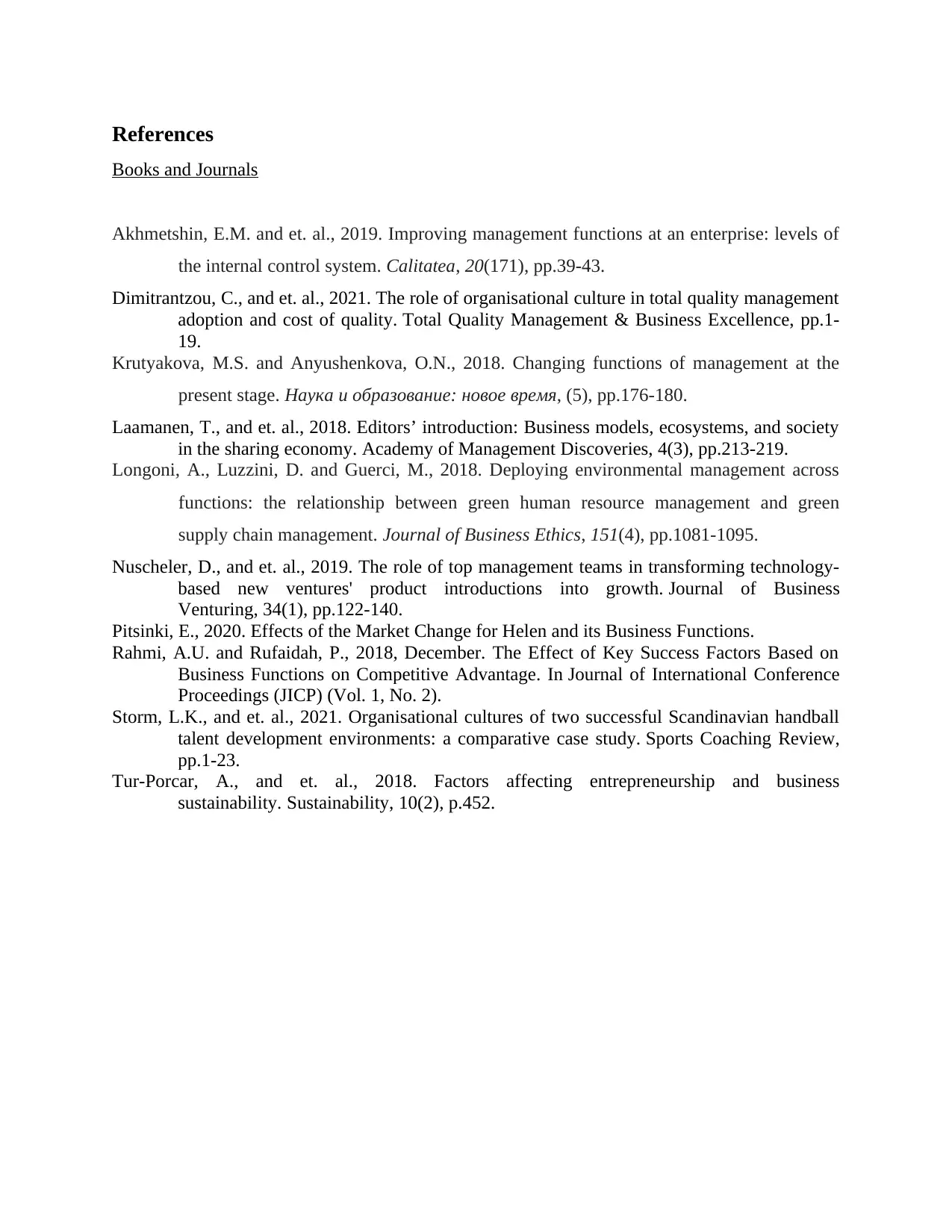
References
Books and Journals
Akhmetshin, E.M. and et. al., 2019. Improving management functions at an enterprise: levels of
the internal control system. Calitatea, 20(171), pp.39-43.
Dimitrantzou, C., and et. al., 2021. The role of organisational culture in total quality management
adoption and cost of quality. Total Quality Management & Business Excellence, pp.1-
19.
Krutyakova, M.S. and Anyushenkova, O.N., 2018. Changing functions of management at the
present stage. Наука и образование: новое время, (5), pp.176-180.
Laamanen, T., and et. al., 2018. Editors’ introduction: Business models, ecosystems, and society
in the sharing economy. Academy of Management Discoveries, 4(3), pp.213-219.
Longoni, A., Luzzini, D. and Guerci, M., 2018. Deploying environmental management across
functions: the relationship between green human resource management and green
supply chain management. Journal of Business Ethics, 151(4), pp.1081-1095.
Nuscheler, D., and et. al., 2019. The role of top management teams in transforming technology-
based new ventures' product introductions into growth. Journal of Business
Venturing, 34(1), pp.122-140.
Pitsinki, E., 2020. Effects of the Market Change for Helen and its Business Functions.
Rahmi, A.U. and Rufaidah, P., 2018, December. The Effect of Key Success Factors Based on
Business Functions on Competitive Advantage. In Journal of International Conference
Proceedings (JICP) (Vol. 1, No. 2).
Storm, L.K., and et. al., 2021. Organisational cultures of two successful Scandinavian handball
talent development environments: a comparative case study. Sports Coaching Review,
pp.1-23.
Tur-Porcar, A., and et. al., 2018. Factors affecting entrepreneurship and business
sustainability. Sustainability, 10(2), p.452.
Books and Journals
Akhmetshin, E.M. and et. al., 2019. Improving management functions at an enterprise: levels of
the internal control system. Calitatea, 20(171), pp.39-43.
Dimitrantzou, C., and et. al., 2021. The role of organisational culture in total quality management
adoption and cost of quality. Total Quality Management & Business Excellence, pp.1-
19.
Krutyakova, M.S. and Anyushenkova, O.N., 2018. Changing functions of management at the
present stage. Наука и образование: новое время, (5), pp.176-180.
Laamanen, T., and et. al., 2018. Editors’ introduction: Business models, ecosystems, and society
in the sharing economy. Academy of Management Discoveries, 4(3), pp.213-219.
Longoni, A., Luzzini, D. and Guerci, M., 2018. Deploying environmental management across
functions: the relationship between green human resource management and green
supply chain management. Journal of Business Ethics, 151(4), pp.1081-1095.
Nuscheler, D., and et. al., 2019. The role of top management teams in transforming technology-
based new ventures' product introductions into growth. Journal of Business
Venturing, 34(1), pp.122-140.
Pitsinki, E., 2020. Effects of the Market Change for Helen and its Business Functions.
Rahmi, A.U. and Rufaidah, P., 2018, December. The Effect of Key Success Factors Based on
Business Functions on Competitive Advantage. In Journal of International Conference
Proceedings (JICP) (Vol. 1, No. 2).
Storm, L.K., and et. al., 2021. Organisational cultures of two successful Scandinavian handball
talent development environments: a comparative case study. Sports Coaching Review,
pp.1-23.
Tur-Porcar, A., and et. al., 2018. Factors affecting entrepreneurship and business
sustainability. Sustainability, 10(2), p.452.
1 out of 8
Related Documents
Your All-in-One AI-Powered Toolkit for Academic Success.
+13062052269
info@desklib.com
Available 24*7 on WhatsApp / Email
![[object Object]](/_next/static/media/star-bottom.7253800d.svg)
Unlock your academic potential
Copyright © 2020–2025 A2Z Services. All Rights Reserved. Developed and managed by ZUCOL.


